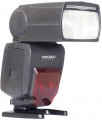Camera compatibility
Camera models that the flash can work with. Note that this parameter is usually indicated in the characteristics very approximately — only camera manufacturers are named, but there is no talk of models as such. Therefore, before purchasing a flash, it makes sense to separately clarify whether it will work normally with your camera — for example, on the manufacturer's website or thematic forums. This is especially true for devices from third-party manufacturers — for such models, the likelihood of problems is somewhat higher than for “native” flash cameras. At the same time, devices from the same company usually have the same requirements for connecting flashes, and therefore this parameter is with a fairly high degree of accuracy allows you to evaluate compatibility.
If the specifications of the flash indicate compatibility with several brands of cameras, this usually means that this model is available in several variations, each of which is designed for a different manufacturer.
It is worth noting that the "non-native" camera and flash may be quite compatible and work fine in most shooting modes. Nevertheless, support for TTL (see below) and a number of other specific functions in this case is usually out of the question, and in general, the reliability and efficiency of this combination is lower than that of a camera with a "native" flash. Therefore, it is better to choose all the same accessories with directly claimed compatibility.
Of t
...he compatible cameras currently in use: Canon, Fuji, Leica, Nikon, Olympus, Panasonic, Pentax, Samsung, Sigma, Sony.Guide number
The guide number is the main characteristic that describes the power of the light pulse of the flash. It is described as the maximum distance (in metres) at which, at ISO 100 and f/1 lens speed (aperture 1), a flash is able to illuminate an "average" subject sufficiently for a normal exposure; in other words, at what distance from the flash it will be possible to normally shoot the scene at the specified ISO and aperture.
There are formulas by which, knowing the guide number, you can derive the practical shooting distance for each specific value of sensitivity and aperture. The simplest formula used to calculate the distance at ISO 100 is: S=N/f, where S is the distance, N is the guide number, f is the aperture value. For example, for a guide number of 56 and an f/2.8 lens, this distance would be 56/2.8 = 20 m. Increasing or decreasing sensitivity by a factor of 2 would increase or decrease the specified distance by approximately 1.4 times, respectively. If you need to calculate the distance as accurately as possible, you should refer to more detailed formulas that can be found in specialized sources.
Separately, it is worth noting that the leading numbers of flashes, usually, are indicated by manufacturers for specific focal lengths of lenses. This is due to the fact that the shorter the focal length and, accordingly, the wider the viewing angle, the more light is needed to illuminate the scene being shot and the more powerful the flash pulse should b...e (at the same distance). Therefore, when choosing by the guide number, it makes sense to pay attention to the focal length indicated by the manufacturer and select a model with a power reserve — especially since guide numbers are often prescribed for rather “long-range” lenses (with a focal length of about 80-100 mm in equiv. 35 mm).
Reload time
The time it takes the flash or generator (for studio flashes) to prepare for the next flash. The smaller it is, the better. This parameter is especially important for continuous shooting, when the interval between frames is small: if you often shoot in this mode, you should look for a flash with the shortest possible recycle time. Also note that the characteristics usually indicate the shortest recharge time; in some operating modes, it may be significantly more than stated.
Pulse duration
The duration of the pulse of light provided by the flash. This indicator can range from thousandths to hundred thousandths of a second; it is usually expressed as a fractional number with a unit in the numerator, such as 1/880 s. The human eye does not notice the difference, but in some shooting modes it can become critical. For example, to capture fast-moving scenes (such as splashing water, the flight of an insect, or the movement of machine parts) you need to choose a flash with the shortest flash duration possible — otherwise the image may be blurry.
The longest pulse duration in modern photoflashes is about 1/800 s; the minimum value can reach 1/30,000 s or even less.
Beam angle
The angle at which the main beam of light from the flash diverges. This parameter is not expressed directly, in degrees, but in terms of the focal lengths of the corresponding lenses, in millimetres: for example, a beam angle of 105 mm corresponds to the angle of view of a lens with the same focal length (35 mm equivalent). This makes it easy to select a flash for specific optics, so that it most effectively illuminates all the space in the frame. And the most advanced modern flashes can have a variable dispersion angle, allowing you to adjust them to different shooting features; this feature is especially useful when using zoom lenses. Changing the angle of dispersion is carried out by a movable lens installed in the flash head, it can be carried out both automatically and manually (for more details, see "Functions and Capabilities").

